Expressionism (1905-1920) was a cultural movement that emerged in Germany in response to widespread anxiety and anguish. If France and Russia had had their revolutions, this was, although later and less violent, an opposition of artists against political and cultural ideologies.
More than a style, it was an attitude of protest and a way of understanding art, which brought together various artists with very different tendencies. It was reflected in many fields such as painting, architecture, cinema, literature, theatre, photography… and even in dance.
Great disillusionment reigned over humanity’s increasingly discordant relationship with the world, and the feeling that united everyone was an almost total loss of spiritual feelings. All this is understandable because this period was sadly marked by the First World War (1914-1918), which changed all vital and artistic schemes.
The Expressionist movement was a reaction against the traditional way of life, against the feudal politics of Kaiser Wilhelm. In the field of art, the painters reacted against French Impressionism, Naturalism and classical academic art. They defended a personal and intuitive art where the inner vision of the artist predominated.
The expressionists were mainly inspired by the esoteric currents of Symbolism at the end of the 19th century. It coincided in time with French Fauvism, a fact that made both of them the first exponents of the so-called Historical Vanguards.
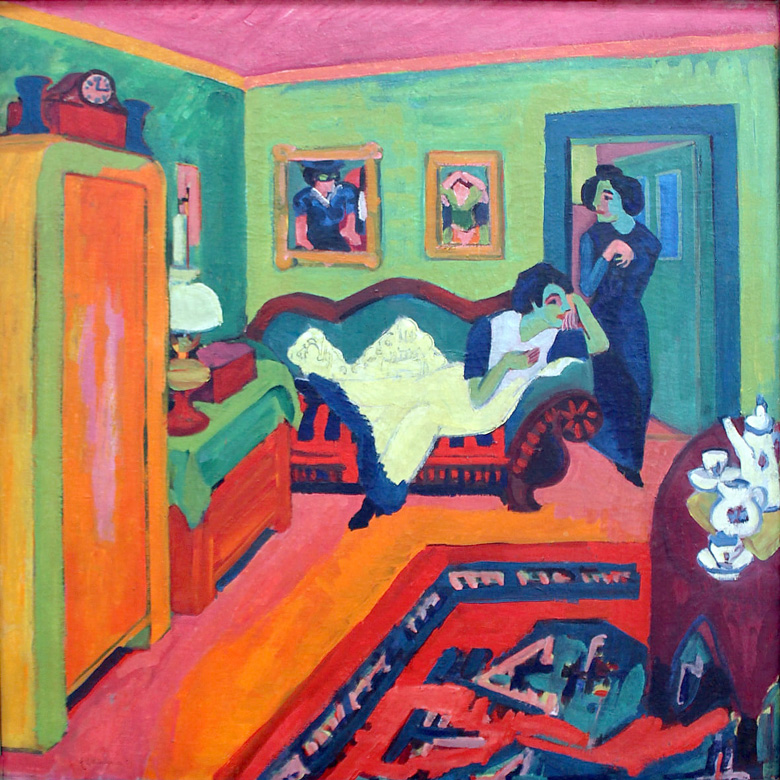
With their violent, almost hysterical colours and their themes of loneliness and misery, they reflected the bitterness that invaded artists and intellectuals. That sadness provoked a desire to change life and to renew artistic languages.
The expressionists had a great admiration for the Norwegian Edvard Munch, the Dutch Vincent van Gogh and the French Paul Gauguin. All three, prior to Expressionism in time, defended a very expressive concept of art and were the pioneers in capturing their inner world in their works.
These precursors, along with James Ensor, were his key influences, being the first to convey endless anxieties and longings. They encouraged the distortion of form, using color with total and absolute freedom.
Expressionism does not seek beauty as an end, but the expression of a state of mind, a feeling, an idea that is born from the artist. They express the dramatic sense, a
state of anxiety, fear, helplessness and loneliness.
At the time, a climate of negativism and depression was generated. It was time to rebel against the academy and against the Kaiser‘s imperialist regime. They were completely against tradition. Thus arises his inspiration from Naive Art, a children’s art that did not require study or rules. Another of his favourite artists was the French Henri Rousseau. The First World War confirmed the fears and the moral decay, contributing to form the dramatic and melancholy character of the artists. They sought to face reality by living brutally honest and without prejudice. All moral concepts ceased to exist.
In Expressionist art the image of reality is distorted to express the deepest feelings of the artist. Pay special attention to his personal world and reflect the effects of the subconscious. A psychologist would clearly see that it was a consequence of the effects of industrialisation and war. They try to capture emotions instead of representing people, events and objects. This artistic movement ignores objective reality to capture what goes through the mind and heart.
Expressionism was a cry of protest, a reaction against life itself, positivism, naturalism and previous styles.
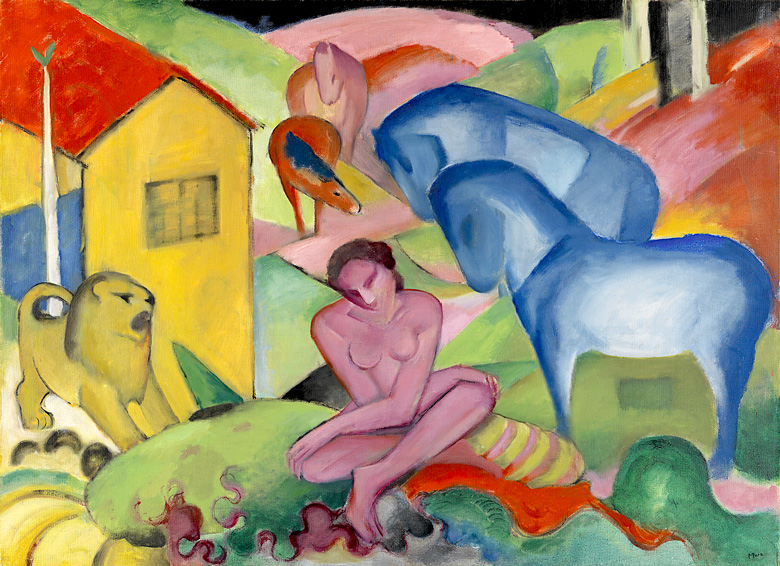
Many artists incorporated fantasy, violence and quasi-pornographic sex into their themes to show extreme emotions such as anger, passion and often the darker side of being human. They show the world from a purely subjective perspective and distort the subject for emotional effect.
Artists want to evoke moods or ideas in the mind of the viewer. To achieve this, they use subjective colours, without any relation to the real colour. For example, they paint a green face and an orange sky. In Expressionist art, chromatism can be very intense and non-naturalistic, the brushwork is gratuitous and the paint application tends to be generous and highly textured. The themes are almost always emotional and sometimes aggressive.
The period began with the founding of a group in Dresden: Die Brucke meaning ”The Bridge” (1905-1913), followed by another group in Munich: Der Blaue Reiter or “The Blue Rider” (1911-1914).
The founders in Dresden were Kirchner, Fritz Bleyl, Erich Heckel and Karl Schmidt-Rottluff. Later Emil Nolde, Max Pechstein and Otto Mueller joined. They were rebellious, aggressive, anti-system and highly dramatic. They distorted reality, depicting ugliness, misery, horror and pain.
The main members of The Blue Rider in Munich were: Kandinsky, Franz Marc, August Macke, Paul Klee and Alexei Jawlensky. There were also two women whose names history seems to have forgotten: Gabriele Munter and Marianne von Werefkin.
Munich was more open than Dresden regarding the arts. This second group was more poetic, refined and spiritual. Instead of deforming, they opt for the purification of forms until they reach abstraction. They were interested in mysticism, symbolism, and primitive, medieval, children’s, and mentally ill art.
Other painters went free, without joining any group, although they were later called “New Objectivity”: Max Beckman, Otto Dix and Georges Grosz. They focused on capturing themes of Berlin between the wars such as violence, prostitution, crimes, madness, suicide…
Although it was an artistic reaction against everything that had gone before, the movement should be understood as a manifestation of the “New Humanism”, which sought to communicate the spiritual life of man. It was a cry transmitted through art, to express the profound intellectual concern caused by the destruction of the hitherto known world.
The First World War (1914-1918) dashed confidence in the future, destroying many of the careers and lives of the best artists. Many of them died tragically, like Kirchner who committed suicide and others like Marc and Macke, who died too young, on the war front.
Franz Marc
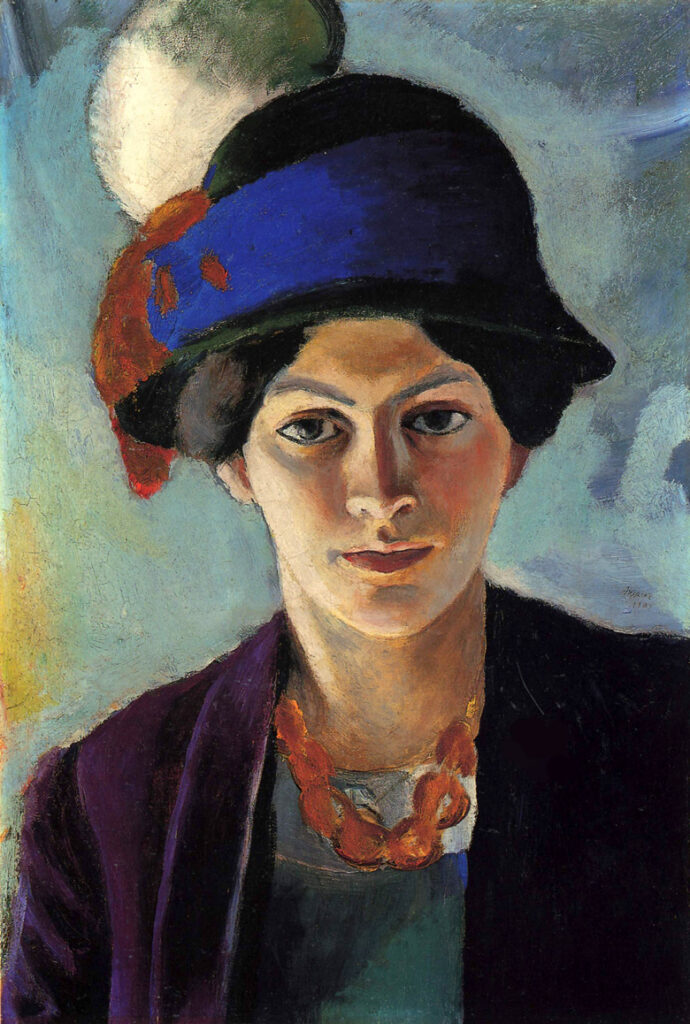
Franz Marc (1880-1916) was a founding member of the Der Blaue Reiter group together with Kandinsky in Munich (1911). The name, which means “The Blue Rider”, arose precisely from the favourite theme in his work: his beautiful blue horses.
He considered animals more worthy of representation than human beings. Little by little horses and foxes would become a main theme of his compositions. He tried to capture his mystical reverence for nature and spirituality in the animal world. He has a relatively unknown painting, with a bucolic theme (but without animals), which is among the best of his output: “Nudes under the Trees”, 1911.
His blue horse paintings show bright primary colours. The blue tone and gentle curvature of the central horses create a sense of harmony, peace and balance against the deep red of the hills in the background.
Marc stated that this contrast showed the juxtaposition between quiet spirituality and violence, evoking a sense of transcendence.
The powerfully simplified and rounded contours of the horses are reflected in the rhythms of the landscape background, uniting the two animals and establishing a vigorous and harmonious organic whole. The curved lines symbolise a sense of harmony, peace and balance in a spiritually pure animal world.
Like Kandinsky, Franz was imbued with an altruistic philosophy. Both wanted to give a spiritual meaning to art.
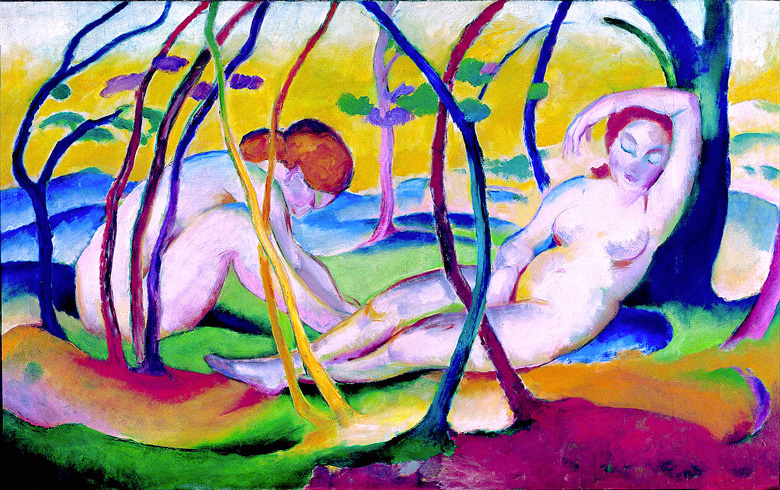
The son of a landscape painter, he began his studies at the Akademie in Munich. In 1903 he traveled to Paris, where he experienced Impressionism first-hand and was particularly drawn to the work of Vincent van Gogh and Paul Gauguin. In 1906 he visited Mount Athos in Greece together with his brother Paul.
He married the artist Maria Franck, of whom he painted a magnificent portrait full of subjective expression. With her he traveled to Lenggries (Bavaria), where he intensified his interest in the study of animals.
In 1910 he met August Macke, with whom he struck up a close friendship. Thanks to him he met Bernhard Koehler, future patron of both.
Marc and Kandinsky organised the first exhibition of the Der Blaue Reiter group in Munich in 1911. They sought to exhibit collectively to show their artistic concept of the expression of the soul. They also published a magazine with their essays that would become a manifesto on the new style, essential for the development of 20th century art.
In 1912 Marc and Macke traveled to Paris, where they met Robert and Sonia Delaunay and experienced the first cubist tendencies. His work is distinguished by bright colours and a more cubist style than his contemporaries. From then on Marc‘s compositions tended towards greater abstraction.
He felt especially close to Kandinsky, with whom he shared the need to spiritually renew Western art. This position caused differences with other members and ended with the split of the group in 1914.
He elaborated his project to illustrate a bible, as a reflection of his deep religious beliefs. At the outbreak of the First World War, Franz volunteered as he fervently believed in the regenerative capacity of war. However, he soon became disillusioned and was killed at the Battle of Verdun in 1916.
August Macke
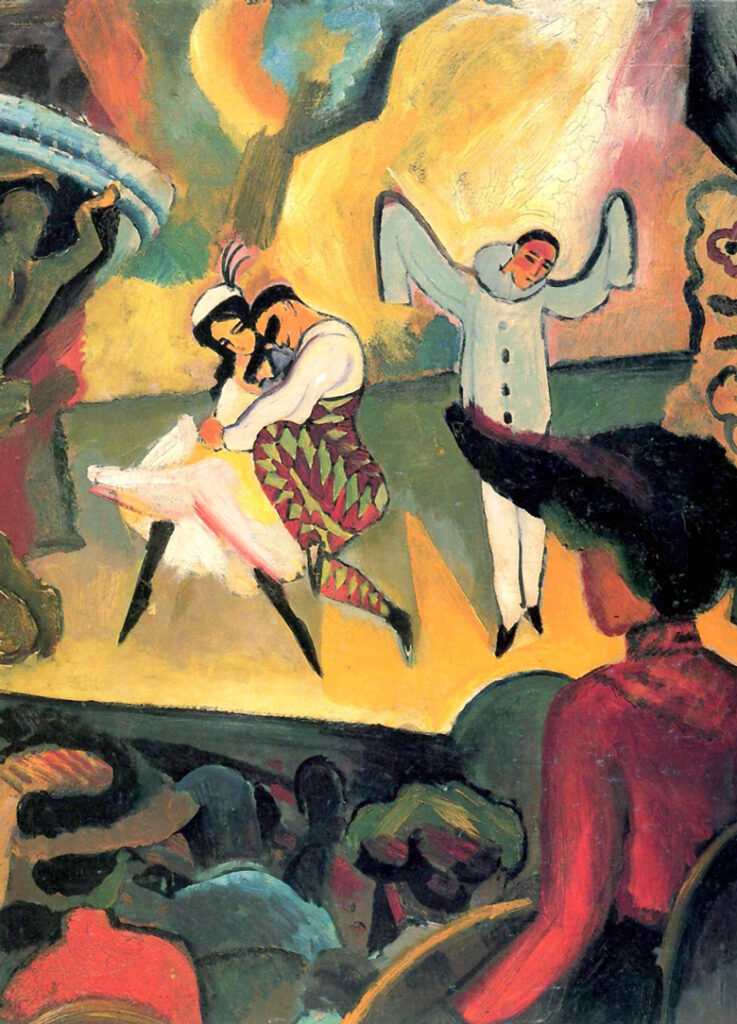
August Macke (1887-1914) is another of the main members of the Der Blaue Reiter group, along with Kandinsky, Paul Klee and Jawlensky.
He lived through an especially innovative period within the artistic environment of his country. While the main expressionist trends were developing in Germany, successive avant-garde movements from the rest of Europe were spreading.
As a true contemporary of his time, Macke knew how to assimilate and integrate into his painting the aspects that most interested him from the different styles that he came to know.
He lived most of his creative life in Bonn, except for a few stays at Lake Thun (Switzerland) and various trips to Paris, Italy and Holland and Tunisia. In Paris he met the work of the Impressionists. Shortly after, in Berlin, he worked for a few months in Lovis Corinth‘s studio.
His artistic style started out influenced by French Impressionism and Post-Impressionism and then went through a Fauvist phase.
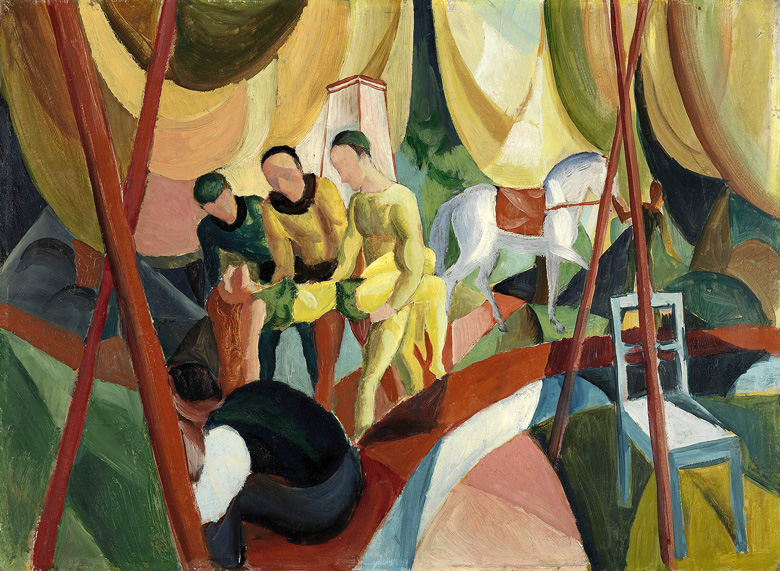
In 1910, thanks to his friend Franz Marc, he met Kandinsky. Since then, he shared the non-objective aesthetics with the mystical and symbolic concerns of the German group.
The meeting in Paris with Robert and Sonia Delaunay in 1912, was for Macke a true revelation. The chromatic cubism of the French artist, baptised by Apollinaire as Orphism, prevailed in his painting.
Macke‘s showcases can be considered a personal interpretation of the famous “Windows” of the Delaunays, combined with the simultaneity of images of Italian Futurism.
In 1914 he traveled to Tunisia together with Paul Klee and Louis Moilliet. The exotic environment was decisive for the creation of the luminist aesthetic at the end of his life. At this stage he made a series of works considered masterpieces of color.
Like his close friend Franz Marc, his career was cut short by an untimely death on the front lines of World War I in 1914. He was only 27 years old.
Ernst Kirchner
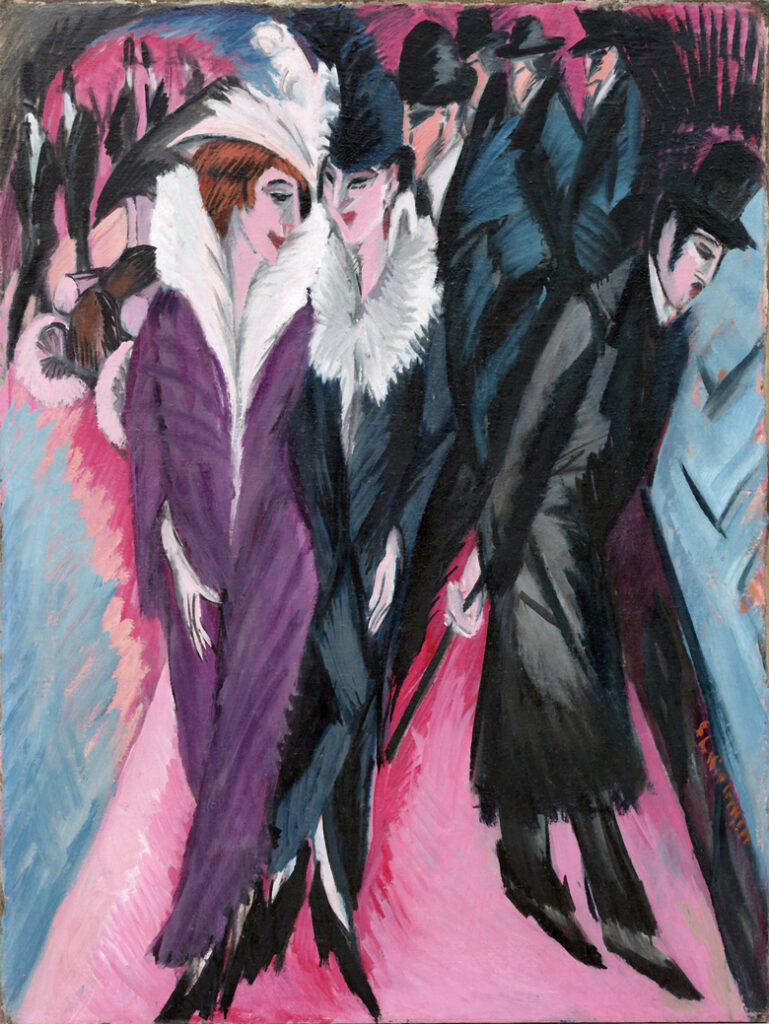
Ernst Kirchner (1880-1938), a German painter and engraver, was another of the leaders of Expressionism. He had a mature and personal style of painting, marked by his psychological tension and eroticism.
Born in Aschaffenberg, he was shocked to discover the works of late Gothic German artists, especially Albrecht Dürer. But the main influence on him was an exhibition by the Norwegian Edvard Munch.
So Kirchner began to simplify his forms and brighten his colours. This development was accentuated by his discovery of African and Polynesian art.
Kirchner studied architecture in Dresden. There he befriended Fritz Bleyl, with whom he shared a radical vision of art and nature.
Along with other architecture students, they created an artistic group called “Die Brücke” (The Bridge) in 1905. Their goal was to create a new mode of artistic expression, forming a “bridge” between the classic works of the past and the avant-garde of the moment.
His works show the influence of Fauvism that triumphed in Paris. In 1906, they held their first exhibition in a lamp factory with the female nude as the main theme. Works like “Woman under a Japanese parasol” are explicitly erotic. In others, his sexual assault fantasy reaches nightmarish intensity.
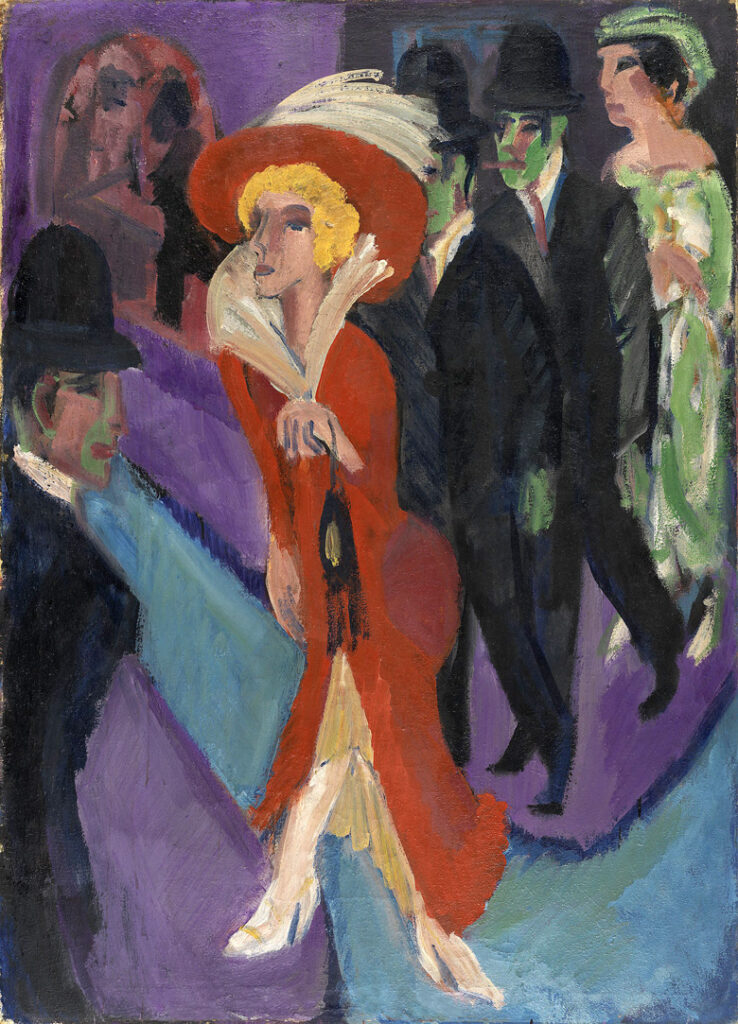
His art was an instant and powerful rendering of her inner conflicts. Kirchner captures his concern for evil and human eroticism. With curvilinear rhythms, his work “Street in Berlin” shows aggressive prostitutes who walk, accentuating a primitive sensuality hidden under fashionable dresses. A sensuality that becomes abominable due to its wild contours and its mask-like faces.
Kirchner joined the German army in 1915 but at the front he suffered a mental and physical collapse that led to his admission to various Swiss hospitals although he never recovered.
The Nazis branded his work “degenerate art” in 1937 and destroyed 600 of his paintings. This forced him to resign from the Berlin Academy of Arts.
The tragic events and aftermath of the war led to a serious depression that finally culminated in suicide near Davos (Switzerland).
A broad concept of Expressionism
It was not a homogeneous movement. Oddly enough, there is a modernist, fauvist, cubist, futuristic, surrealist, abstract expressionism, etc…
The term is specifically associated with modern German art, in particular the Die Brücke and Blaue Reiter groups.
Although it emerged in Germany, Paris School artists such as Modigliani, Chagall and Soutine painted in their own expressionist style. French and Germans exhibited together at the beginning of the 20th century.
With a destruction of three-dimensional space, they used symbolic themes to talk about death and pain. It was a personal and intuitive art with strident colours, very angular shapes, nervous brushstrokes and drama. All to make its message better understood, a cry that never sought to be a mystery, quite the opposite.
The paradox is that the term “expressionist” can be applied to works of art from any period, even earlier. I dare say it could start with Goya and his black paintings or even Hieronymus Bosch.
In the 20th century, it forms an important current of modern art that includes, among others, Vincent Van Gogh, Edvard Munch, Modigliani, Soutine, Georges Rouault, Egon Schiele, Oskar Kokoschka, Paul Klee, Max Beckmann, Pablo Picasso, Henry Moore, Graham Sutherland, Francis Bacon, Alberto Giacometti, Jean Dubuffet, Georg Baselitz, Anselm Kiefer… up to the Neo-expressionism of the eighties.
After World War II, a new form of this style developed in America, known as Abstract Expressionism.
If I had to choose a final concept to describe the broader term of Expressionism in art, I would say that it is about distorting the vision of the outside world to show the feelings and emotions of the inner world in the subconscious of the artist. To sum up:
Expressionism is closing one’s eyes to reality in order to express what is going on inside the mind and heart.
Munch and van Gogh, precursors of Expressionism
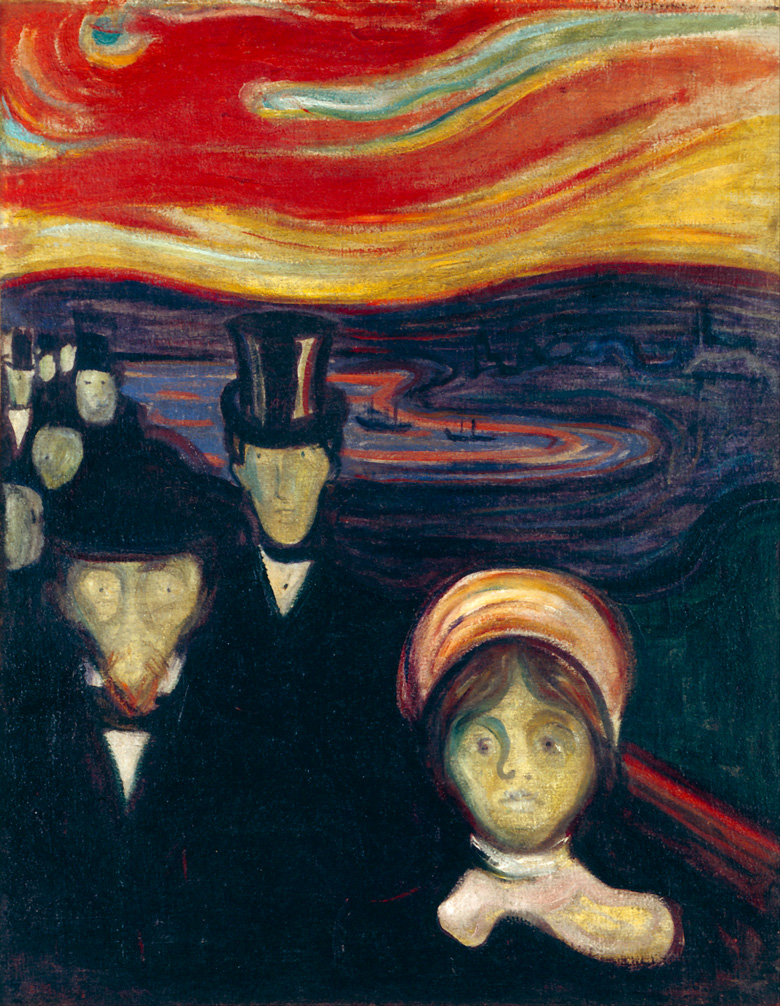
Although they were born almost half a century earlier and were not German, Edvard Munch and Vincent van Gogh are considered key forerunners of Expressionism because of the strong expressiveness of faces and the raw psychology in all their work.
Van Gogh was a great mad genius, deified today but totally misunderstood during his lifetime. He lived to paint what his sick soul felt and he could never sell a single painting.
Also Munch was constantly tortured by her devious mind and his sad existence. Both expressed their deepest feelings, painting human tragedies such as loneliness, anguish, death and eroticism.
Precisely these would be years later, the favourite themes of the expressionists.
Munch‘s “The Scream” is one of the most iconic works of modern art, but if there is one painting that has become a cultural icon of our era, it is Van Gogh‘s “Starry Night.”
Interestingly, two of the painting’s icons embody the deep sense of anguish and anxiety that pervaded the modernist era.
Both are based on the dramatic experiences of their authors, who paint, as if shouting at the world with their brushes, expressing their deep despair.
Although they are earlier (1893 and 1889) and do not belong to any Expressionist group, they were undoubtedly an inspiration and reflect the spirit that beats in the philosophy of this movement that has so influenced artists of the 20th and 21st centuries.
Just as Leonardo Da Vinci studied human anatomy by dissecting bodies, I try to dissect souls.
Munch

